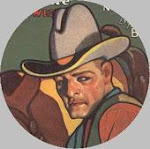According to Wikipedia, The
Ruthless Men was the second of four novels written by Lewis B. Patten
published in 1959. All were paperback originals. This and one other of the four
were published by Fawcett Gold Medal. The other two were published by Avon
Books.
Patten had been publishing novels for seven years by this
time—his first published story,
according to Robert E. Briney in The Best
Western Stories of Lewis B. Patten by Bill Pronzini and Martin H. Greenberg
[Southern Illinois University Press: 1987], appeared in the April 1950 issue of
Zane Grey’s Western Magazine.
According to the “Bibliography of Western Publications,” Ruthless Men was his twenty-first novel for adults (Pronzini and
Greenberg)—he’d also written at least three novels for younger readers
featuring Gene Autry and Jim Bowie (what we’d call tie-in novels today) for
Whitman Books and Big Little Books.
All that preamble is to say, Patten’s apprenticeship was
done by 1959. He knew what he was doing as a storyteller of traditional
westerns. For the most part, The Ruthless
Men demonstrates the truth of that statement. In other ways, it also
demonstrates that Patten hadn’t yet achieved mastery in his storytelling
efforts. There was still time for that. After all, his last novel wasn’t
published until 1980.
The Ruthless Men
focuses on Luke Partin, who opens the novel intending to kill a man he’s
tracked for days after he follows his trail from the house of a family who’s
been butchered. Years before, the family had nursed Luke back to health after
he’d been left for dead by Apaches. For Luke, this vengeance trail is a way to repay
a debt and assuage his fury.
After Luke succeeds in his quest, his target’s surviving
family members set after him on an enraged vendetta. This sets up a long
chase-and-fight narrative that drives Luke to the end of his reserves and lets
Patten show a character dealing with deadly situations as he nears the end of
his rope.
This narrative landscape allows Patten to demonstrate his
skills at showing a hero under stress—something he did very well for years in
nearly all his books—as Luke must deal with the ramifications of his vengeful
ride.
On the other hand, the story relies on melodrama and
pulp-magazine-style schemes and strategies for scenes featuring ambush and escape to
support its plot. While Patten’s pacing and characterizations keep a strong
grip on the reader’s attention, the pulpy flavor of some of the drama shows
that his mastery of the traditional western isn’t quite complete. For instance,
some of the subtlety Patten would employ in later novels isn’t quite evident
here:
<<
Riding away, Nancy Holcomb glanced up at the foot of the rim
and saw Luke watching her. She raised a hand, then dropped it abruptly and
turned her face away.
She hated him. He was brutal and savage and had probably lied
about the man he had killed and about those who were following him.
And yet, if she hated him, why did she feel such shame at
leaving him thus? Why did she feel like weeping all over again, just as she had
last night? (p. 39)
>>
This is rather simplistic emotional turmoil. It may form the reality of some folks' perceptions at some level, but Patten drops it on the page in a rather raw form,
belying his efforts to describe his characters as having more complicated or
mature interior lives. The nuanced emotional and psychological portraits readers have come to expect from Gold Medal's genre novels isn't entirely on display here, but the sort of fast-moving action novel that readers look for—or at least I look for—in Fawcett westerns is certainly evident in The Ruthless Men.
Still, these quibbles shouldn’t stop you from seeking and
reading this early-ish novel by a writer who would win three Spur Awards and
become a master of the traditional western.








1 comment:
Great review! I stumbled on Patten when I was turning the spinner rack looking for a Louis L'Amour book, back when I was a youngster. So I've been reading Patten for most of my life and I find him just as enjoyable as I did back in the day.
Post a Comment